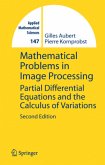This book introduces the reader to a recent theory in Computer Vision yielding elementary techniques to analyse digital images. These techniques are inspired from and are a mathematical formalization of the Gestalt theory. Gestalt theory, which had never been formalized is a rigorous realm of vision psychology developped between 1923 and 1975.
From the mathematical viewpoint the closest field to it is stochastic geometry, involving basic probability and statistics, in the context of image analysis.
The book is intended for a multidisciplinary audience of researchers and engineers. It is self contained in three aspects: mathematics, vision and algorithms, and requires only a background of elementary calculus and probability. A large number of illustrations, exercises and examples are included. The authors maintain a public software, MegaWave, containing implementations of most of the image analysis techniques developed in the book.
From the mathematical viewpoint the closest field to it is stochastic geometry, involving basic probability and statistics, in the context of image analysis.
The book is intended for a multidisciplinary audience of researchers and engineers. It is self contained in three aspects: mathematics, vision and algorithms, and requires only a background of elementary calculus and probability. A large number of illustrations, exercises and examples are included. The authors maintain a public software, MegaWave, containing implementations of most of the image analysis techniques developed in the book.
From the reviews: "This book tells the story of how to construct objects form images, in a way closely related to human perception. ... contains many illustrations and images that are analyzed, from various fields of applied science. ... References in the end, however, are helpful for further reading. ... To summarize, the book is a fine and timely introduction to a fascinating field of science. I can certainly recommend its reading to anyone dealing in a probabilistic sense with images ... ." (A. Stein, Kwantitatieve Methoden, Issue R09, 2008)








